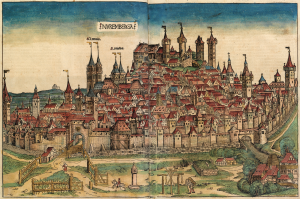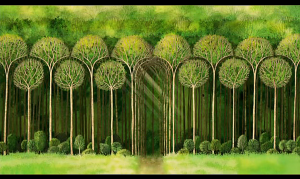In the chapter “I Am Tree” from My Name is Red, an illustrated tree from an illuminated manuscript actively distinguishes itself from the more intentional and realistic figures found in European art. This foreshadows the conflict at the heart of the book-the disparity between Islamic and European art and the way it reflects traditions of culture and of faith. The tree denounces the aspiration to realism and attention to detail in European art, clinging desperately to the decorative tradition of Islamic art.
The chapter closes with a declaration: “I don’t want to be a tree, I want to be its meaning.” Through the voice of the tree, Pamuk suggests that Islamic art (of the time) demanded a clean separation between art and life. Art is ornamental, fabricated, ethereal. The presence of the colloquial, of the faces of friends and community members in an artistic work, diminished its magic. The tree continues, “I thank Allah that I, the humble tree before you, have not been drawn with such intent.” In rejecting intent, the tree suggests an appreciation of the spontaneity and artistic liberty that characterizes the creative process in illumination. Illuminators were not necessarily given rigid instructions, and instead offered the freedom to articulation individual visions. In contrast, European artists were confined by the aspiration to imitate life as closely as possible, essentially unable to express individual styles.
Pamuk then draws a distinction between an object and its meaning. The object is plain and two dimensional, simple and undeserving of further explanation. Meaning can be entirely separate, and alive, animated, but not necessarily attached to its real life object. The tree in the manuscript declares itself “the meaning of a tree,” as separate from the tree itself.
The issues that the tree raises reminded me of the Magritte painting, La trahison des images. Viewers have to think about the nature and meaning of images in this work…Is this a pipe, or is this a picture of a pipe?
The statement below the illustration declares, “This is not a pipe.”
Magritte at once acknowledges and pokes fun at the ambiguous language that blurs the separation between an image and a real object. The tree probes a similar distinction, yet declares one superior to the other. Meaning: liberal artistic expression rises above the actual object or any attempt to realistically imitate it.






